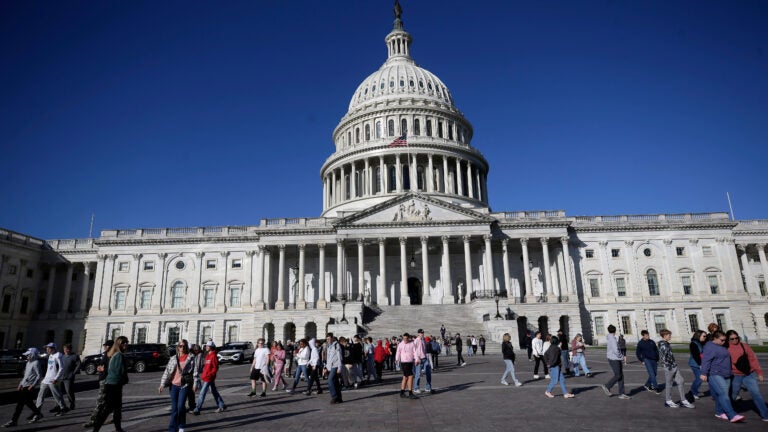Politics
As Washington’s stalemate continues into its fourth week with no end in sight, it’s looking like this could become one of America’s longest funding lapses.

The economic effect of past government shutdowns has been straightforward. The economy loses some activity for a few weeks, then gains it back after the government reopens. The net cost is basically zero.
This time, the math may not be so benign.
As Washington’s stalemate continues into its fourth week with no end in sight, it’s looking like this could become one of America’s longest funding lapses. During the previous record-holder, a 34-day closure in 2018, Congress passed enough appropriations bills to keep more of the government funded. This time, none have been passed.
And the White House is attempting to lay off thousands of people and threatening to withhold back pay for furloughed workers, despite a 2019 law requiring that they be paid. “That would obviously make it a larger macroeconomic impact,” said Michael Zdinak, a director on the U.S. economics team at S&P Global Market Intelligence.
Then there are the services those workers aren’t providing — including national park tours and new drug reviews — that support commerce. For many businesses, the timing couldn’t be worse, with the holiday season approaching and economic uncertainty already high.
“If you’re worried about the potential for those indirect impacts, those only increase the longer the shutdown goes on,” Zdinak said.
Economists estimate the shutdown will trim between 0.1 and 0.2 percentage points off annual growth in economic output for each week it drags on. That amounts to between $7.6 billion and $15.2 billion a week based on hours that government employees aren’t working, according to Oxford Economics. The 2018 shutdown trimmed slightly less than 0.1 percentage points off annual growth per week, according to the Bureau of Economic Analysis.
That estimation does not capture the ways federal services support economic activity in other sectors, where the effect could be narrow but deep. Consider visa processing. Much of it is performed by contractors, who were told to stop work on Oct. 1. Unlike government employees, they will not be paid back when the shutdown ends.
Brandon Muniz owns a Maryland information technology provider, HeiTech Services, which relies on federal contracts. He has already lost business this year because of government cost-cutting, and over the past couple of weeks he has had to cut hours for staff members who can’t evaluate applications for green cards and employment-based visas until the government reopens. Muniz has had to lay off 15 people this year and furlough another 25 because of the shutdown. He worries about getting them back if they find other jobs and keeping the business afloat in the meantime.
“All of our indirect costs for our headquarters team, the facilities, the vehicles that they have, we still have to pay for,” Muniz said. “Those are things we factor in when we write up a proposal for a contract, but it’s very difficult to factor in something like a shutdown.”
The individuals and businesses that HeiTech serves — like farmers, operators of seasonal attractions and seafood processors — are dealing with delayed visa applications.
Small companies that depend on one or two foreign workers with specific skills are in limbo, said Mark Neuberger, a lawyer with Foley & Lardner in Miami who helps clients with labor issues. “Even a short shutdown gums up the works for months, and they have to clean up the mess from when they were gone,” Neuberger said.
The federal government also guarantees a significant share of credit markets through agencies whose work has been significantly curtailed, including the Small Business Administration and the Department of Agriculture.
The pause in federal loan processing poses the largest obstacle for low-income borrowers who would qualify for a mortgage backed by the Agriculture Department’s program for rural areas. But even people with approvals for private mortgages in disaster-prone areas are getting tripped up because they have no access to the National Flood Insurance Program.
For farms and small businesses, October is a critical month for borrowing money. Some are paying their taxes, having gotten a six-month extension from the spring. Others are trying to stock up on inventory, or purchase equipment for the upcoming planting season.
Federal agencies generally offer more affordable terms than private lenders, and if they’re not available, borrowers may resort to pricier options.
“They will try not to invest money or hire more people right now,” said Rohit Arora, the CEO of Biz2Credit, an online lending platform. “If that doesn’t solve the problem, credit cards come first, but there will be a subset of customers who will be forced to borrow at a much higher cost.”
The timing of the shutdown is problematic for another reason: Monetary policymakers are fumbling forward without critical labor and inflation data produced by statistical agencies.
The economy is already approaching stall speed and being battered by tariffs and aggressive immigration enforcement. Missing signs of a more serious downturn — or an acceleration — could lead officials to make a decision on interest rates that they might regret when the data becomes clearer.
Federal data informs smaller decisions, too. The Department of Agriculture produces weekly reports on production and global demand that help farmers decide where to market their crops and what to plant next year.
“This is not a great time for the lack of information,” said Todd Davis, the chief economist with the Indiana Farm Bureau. “Farmers are trying to make business plans, pacing their production, whether they want to sell it at harvest or make decisions on storing and carrying it into later this year or early next year to find a higher price.”
Janet Lowry, 75, a former professor, has been furloughed from her part-time position as a field representative for the Census Bureau in southwest Indiana, a $15-an-hour job that provided some extra income to supplement her savings. She said the lost data was even more important to her than the missed paycheck.One program she is responsible for is the monthly Survey of Construction, which requires calling builders in Fort Smith, Arkansas, to see how many housing units they’re adding and when they will be completed.
“That’s used by all kinds of people to determine what’s going on in the economy in that area, the need for new appliances and the amount of housing available and things like that,” Lowry said. “October is blown.”
Like the federal workforce cuts that President Donald Trump has already imposed, the pause in government operations is most acutely felt in the national capital region. Virginia, which has already lost 10,000 federal jobs this year, is forecasting an overall contraction in employment for 2025 for the first time, outside of the pandemic, since the Great Recession.
The lost jobs and paused wages are leading more people to seek food assistance, according to the Capital Area Food Bank, which has opened extra sites this week specifically for federal workers going without pay. Rosie Allen-Herring, the CEO of the region’s United Way, said there was another problem: Federal workers have historically given generously to the organization through the combined federal campaign. The period when they would typically be deciding what they will give next year is coming up.
“Those contributions that we were counting on, to help those who are already in need, are in jeopardy and have been diminished,” Allen-Herring said. “Now what do you do when someone who used to be your donor becomes a client?”
There are many other ways that suspended government services could dampen economic activity. Permits aren’t being issued, research grants aren’t being processed, construction contracts aren’t being executed, products aren’t being vetted. If ships start to back up at ports because of short staffing at customs offices, perishable goods could spoil, and airline delays are mounting.
But some of the more serious ramifications come from risks that aren’t being managed. It is hurricane season, for example, and small disasters can become larger ones if the National Weather Service can’t warn communities about a storm and if the Federal Emergency Management Agency isn’t at full force to respond.
David Bernstein, a consultant with a firm called BSI who helps companies plan for emergencies, said businesses could confront disruptions beyond the variables they normally tracked.
“That realm of influence has to grow wider and wider because you can’t control all of those other things that are happening,” Bernstein said. “And you’re going to start to see those cascading impacts coming through.”
This article originally appeared in The New York Times.
Extra News Alerts
Get breaking updates as they happen.



